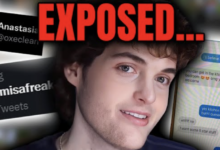Stefanie Knight Babygmag Leaked Video Scandal
The digital realm is rife with both opportunities and challenges, as the unfortunate incident of the ‘Stefanie Knight Babygmag Leaked Video‘ reveals. Surfacing without permission, this video has stirred significant discourse on consent, privacy, and the responsibilities that come with social media usage. Our digital landscape at “Goldsport” reminds us that the lines between public and private spheres are blurrier than ever, and the ramifications can be profound. As this story unfolds, it compels us to consider the delicate balance of sharing and safeguarding our digital footprints.
| Key Points | Details |
|---|---|
| Video Origin | Leaked from private Snapchat, early 2021 |
| Content Nature | Explicit material without consent |
| Impact on Stefanie Knight | Issued condemning statement, reputation affected |
| Legal Consequences | Potential privacy and copyright violations |
| Social Media Ethics | Raises questions on consent and privacy |
| User Responsibility | Emphasizes the need for responsible social media use |
I. Understanding the Impact of the ‘Babygmag Leaked Video’
At the heart of the ‘Babygmag Leaked Video’ controversy is the viral sharing of private content without consent, an act that reflects a serious breach of trust and personal boundaries. The incident not only grabbed headlines but also shone a spotlight on the ethical pitfalls of digital content sharing. The video, obtained from a social media personality’s private Snapchat account, was never meant for public consumption. Its unauthorized distribution led to a ripple effect, tainting not just the personal reputation of Stefanie Knight, a figure associated with the account, but also sparking a broader conversation about the protection of online privacy.
The outcry following the release of the video is a stark reminder of the lasting impact such invasions can have on an individual’s life. Beyond the immediate social and personal repercussions, there’s a wider societal concern about how digital content is handled. This debate touches on elements of consent, exploitation, and the mechanisms of control within social media spaces. Without stringent norms and awareness, such incidents highlight a growing need to reassess our digital conduct and the protection it affords to personal content.
| Concern | Impact |
|---|---|
| Online Privacy | Heightened awareness and call for better safeguards |
| Consent Violation | Undermining trust in digital communication channels |
| Reputational Damage | Long-term effects on individual’s public image |
| Digital Conduct | Need for responsible sharing and content management |
II. Ethical Implications of Private Content Leaked Online
When private content makes its way onto the public stage without consent, it opens a Pandora’s box of ethical concerns. The “Stefanie Knight Babygmag Leaked Video” serves as a case in point. Initially intended for a private audience, its unauthorized distribution raises important questions about the right to privacy in the digital age. Individuals have the fundamental right to control their personal information and image, a boundary clearly overstepped in such incidents. Moreover, the leak of sensitive material can inflict emotional distress and reputational damage, highlighting the need for stricter digital boundaries and respect for personal content.
The ethical breach is compounded when considering the invasiveness of sharing explicit content without consent. Those who distribute such content contribute to a culture of exploitation and potentially coerce individuals into undesired public scrutiny. Not only does it demonstrate a lack of respect for the individual’s autonomy, but it also disregards the psychological impact on the person at the center of the leak. Discussions following the “Stefanie Knight Babygmag Leaked Video” have illuminated the disturbing trend of dismissing consent in the digital realm, an issue desperately needing address and recalibration of social norms.
| Violation Type | Consequences |
|---|---|
| Invasion of Privacy | Emotional distress, reputational damage |
| Lack of Consent | Loss of autonomy, psychological impact |
| Cultural Impact | Contributes to a culture of exploitation |
III. Understanding the Legal Boundaries of Explicit Media Sharing
The release of explicit content without consent constitutes a serious breach of privacy and can be subjected to strict legal action. In the wake of the Stefanie Knight Babygmag video leak, it’s essential to grasp the boundaries set by law to respect personal autonomy. Copyright laws protect the original creator of content, and when private media is distributed without permission, it can infringe on these rights. Moreover, privacy laws exist to shield individuals from unauthorized exposure of their most intimate moments. The violation of these laws may result in legal penalties that underscore the severity of such actions.
In the context of non-consensual media dissemination, the repercussions for distributors can be extensive, often involving civil or criminal charges. The individuals affected have the right to seek justice and reparations for the damages incurred. This could mean substantial fines, and in some jurisdictions, even imprisonment for the perpetrators. The Stefanie Knight case highlights a growing need for stricter enforcement of these laws to deter potential violators and protect individual privacy in the digital space.
| Legal Aspect | Potential Repercussions |
|---|---|
| Copyright Violation | Legal penalties, fines |
| Privacy Breach | Compensation for damages, injunctions |
| Criminal Offense | Imprisonment, criminal record |
IV. Stefanie Knight’s Response to the Babygmag Video Leak
When the ‘Stefanie Knight Babygmag Leaked Video’ surfaced online, shockwaves rippled through social media circles. Central to the controversy was Knight’s response, a powerful denouncement of the video’s non-consensual release. She took to various platforms to voice her disapproval, emphasizing the profound intrusion on her privacy and autonomy. Her statement not only served as a denunciation but also shone a light on the broader societal issue of digital consent.
The incident prompted swift reactions across the internet, with supporters rallying behind Knight to condemn the breach of trust. Deploying strong words, Stefanie made it clear that such acts were not just personal violations but potentially criminal offences. Her stance brought to the forefront the pressing need for heightened awareness around the sharing and distribution of private content. The dialogue opened by this event piggybacked on growing demands for a safer, more respectful online community.
| Public Reaction | Support for Stefanie Knight’s stance against the leak and privacy invasion. |
|---|---|
| Knight’s Official Statement | A clear denouncement of the unauthorized distribution of the leaked video. |
| Implications for Online Safety | Highlighted the necessity for better protection of digital privacy rights. |
V. Social Responsibility and the Role of Social Media Users in Preventing Leaks
When private content like the ‘Stefanie Knight Babygmag Leaked Video’ surfaces, it underscores a crucial call to action for social media users. Indeed, it’s more than personal caution; it’s a collective responsibility to respect privacy boundaries and discourage sharing invasive content. By harnessing social ethics and digital civility, each user becomes a proactive guard against the unauthorized spread of materials that can devastate reputations.
VI. Privacy Invasion: A Growing Concern in the Digital Age Highlighted by the Babygmag Leak
The incident involving the ‘Stefanie Knight Babygmag Leaked Video’ underscores a pivotal issue in our society’s increasing reliance on technology: the ease with which personal privacy can be breached. In the digital age, where our lives are often an open book to the online world, the concept of privacy takes on new dimensions. The ubiquitous nature of social platforms enables users to share content broadly, but this also presents a double-edged sword when such sharing is done without consent. The Babygmag leak epitomizes a deep-seated problem – that private moments, once thought to be secure within the confines of a personal account, are vulnerable to intrusion and exploitation.
Despite the suggestive allure of ever-connected social ecosystems, the leak acts as a glaring reminder of the delicate balance between online openness and personal security. Users often underestimate the potency of digital footprints and the permanence of online actions. Once leaked, content like the Babygmag video becomes almost impossible to retract, leaving an indelible impact on the individuals involved. This episode sparks a much-needed dialogue about the protection of personal spaces in a world where digital barriers are easily overridden by those with malicious intent.
| Considerations for Digital Privacy | |
|---|---|
| Consent for Sharing | Essential for maintaining individual autonomy online |
| Impact of Leaks | Lasting mark on personal reputation and mental health |
| Preventative Measures | Stronger security protocols and awareness can fortify privacy |
VII. Best Practices for Protecting Personal Content Online to Avoid Incidents Like the Babygmag Leak
In the wake of incidents like the Babygmag leak, safeguarding personal content has never been more critical. It’s essential to utilize strong, unique passwords and enable two-factor authentication to guard against unauthorized access. Be judicious in what you share and with whom, considering the potential for content to be disseminated beyond the intended audience. Awareness and proactive measures can fortify your digital privacy and diminish risks of unwanted exposure.
VIII. Strengthening Digital Defenses in the Wake of Leaks
The leak of the ‘Stefanie Knight Babygmag’ video brings to forefront critical discussions about individual privacy rights and digital security. It unequivocally shows that our online actions have real-world repercussions, especially when dealing with sensitive content. Users must navigate the digital space with caution, understanding the need for consent and respecting personal boundaries. Meanwhile, platforms must enforce stronger protective measures to shield users from such exploitations. Ultimately, finding a synergy between technology use and ethical standards is key to maintaining personal integrity and security in an increasingly connected world.
The content of this article is a compilation of information drawn from various sources, including Wikipedia.org and different newspapers. Though we have endeavored to ensure the information’s reliability, we cannot assert that all details are thoroughly accurate and confirmed. Therefore, we advise caution when relying on this article for scholarly reference or as a basis for research and reports.





